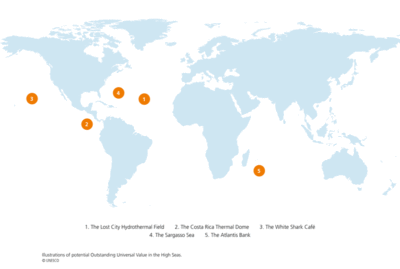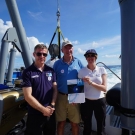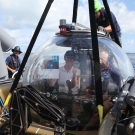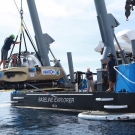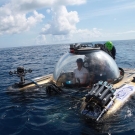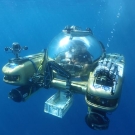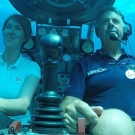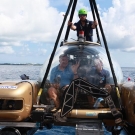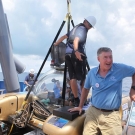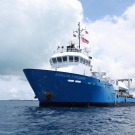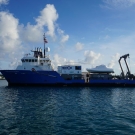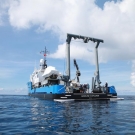High Seas
The High Seas – areas of the open ocean outside of national jurisdiction – cover half our planet, but few protections exist for the vibrant marine ecosystems, iconic ocean species, and spectacular deep-sea communities that call these waters home. Today, the High Seas remain the largest gap in marine conservation, despite the growing body of scientific information that has emerged on the importance of the marine ecosystems that exist outside the boundaries of any nation.
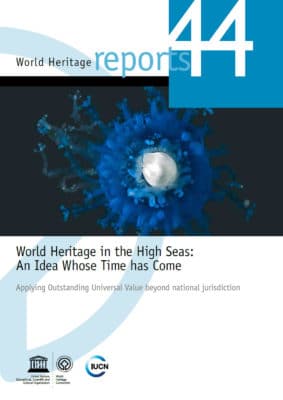 Embodying our motto Science Without Borders®, the Khaled bin Sultan Living Oceans Foundation has supported the efforts of the UNESCO World Heritage Centre Marine Programme to identify ways in which World Heritage status could be used to protect outstanding places on the High Seas. This project resulted in the publication of World Heritage in the High Seas: An Idea Whose Time has Come, a report by UNESCO and IUCN that proposes multiple ways in which World Heritage status could be used to protect places on the High Seas.
Embodying our motto Science Without Borders®, the Khaled bin Sultan Living Oceans Foundation has supported the efforts of the UNESCO World Heritage Centre Marine Programme to identify ways in which World Heritage status could be used to protect outstanding places on the High Seas. This project resulted in the publication of World Heritage in the High Seas: An Idea Whose Time has Come, a report by UNESCO and IUCN that proposes multiple ways in which World Heritage status could be used to protect places on the High Seas.
The report goes on to advocate for the creation of High Seas Marine Protected Areas (MPAs), and highlights five sites of potential outstanding universal valuewhich are so special – just like the Taj Mahal, the Grand Canyon, and the Great Barrier Reef – their importance transcends national boundaries:
- The Lost City Hydrothermal Field, a wonderland of towering ancient spires rising from the depths of the Atlantic Ocean.
- The Costa Rica Thermal Dome, an extremely productive region in the Eastern Pacific where whales and dolphins congregate in massive numbers.
- The White Shark Café, a spot in the open ocean between California and Hawaii where sharks and other large pelagic predators gather, presumably to feed and mate.
- The Sargasso Sea, a place of myth and legend where Sargassum seaweed provides a home for a myriad of interesting creatures that hide within the branches of this floating rainforest.
- The Atlantis Bank, a sunken fossilized island deep in the Indian Ocean.
“World Heritage is a simple idea but a revolutionary one: that the planet’s most unique and special places belong to all humankind, and we have a shared responsibility to protect them. The World Heritage Convention already provides a framework for protecting the High Seas; we just need new processes to support nomination and protection of such sites.” – Dr. Fanny Douvere, Head of the Marine Programme at the UNESCO World Heritage Centre.
Last month in Bermuda, the Khaled bin Sultan Living Oceans Foundation headed out to sea with Dr. Fanny Douvere of the UNESCO Marine World Heritage Centre to officially launch the publication of “World Heritage in the High Seas: An Idea Whose Time has Come” on a Nekton Mission submersible deep in the Sargasso Sea.
Related Publications:
-
2016
World Heritage in the High Seas: A New Ray of Hope for Our Ocean Commons
The High Seas span our globe, covering half the earth. But they are unprotected. The UNESCO World Heritage Marine Programme, in close collaboration with IUCN, is exploring the potential of the 1972 World Heritage Convention to preserve places in areas …
-
2016
World Heritage High Seas Report
Embodying our motto Science Without Borders®, the Khaled bin Sultan Living Oceans Foundation has supported the efforts of the UNESCO World Heritage Centre Marine Programme to identify ways in which World Heritage status could be used to protect outstanding places …
-
2016
UNESCO Expands World Heritage Sites Into the Deep Ocean
This article in Yale University’s Environment 360 online digest highlights how UNESCO Expands World Heritage Sites Into the Deep Ocean to include deep-sea ecosystems of outstanding universal value. This campaign has been supported by Khaled bin Sultan Living Oceans Foundation, embodying our theme …
-
2016
United Nations report urges expanding World Heritage sites to high seas
This article in Science Magazine highlights Living Oceans Foundation sponsored campaign with UNESCO to expand its World Heritage sites to include the high seas. United Nations report urges expanding World Heritage sites to high seas Science Magazine August 4, 2016 …
